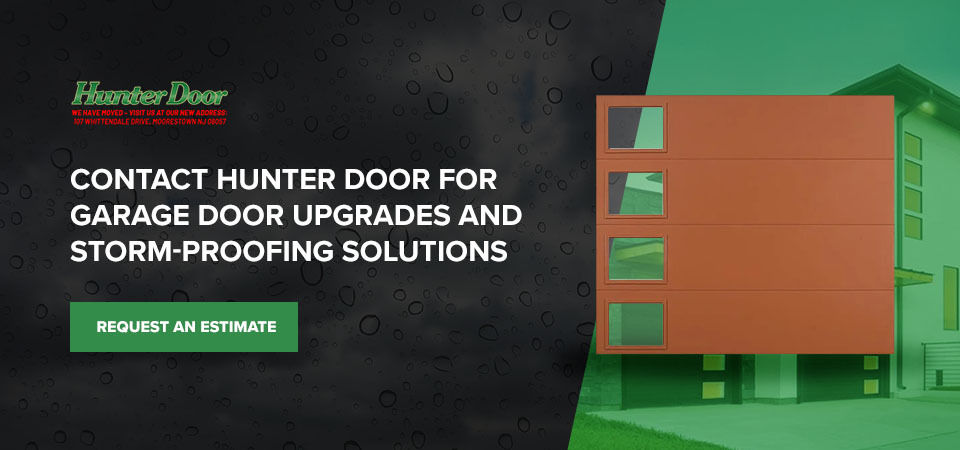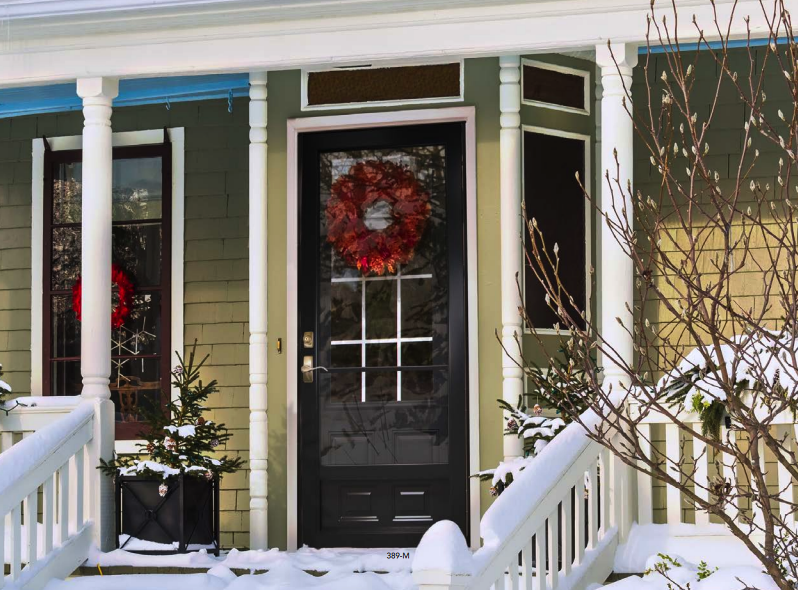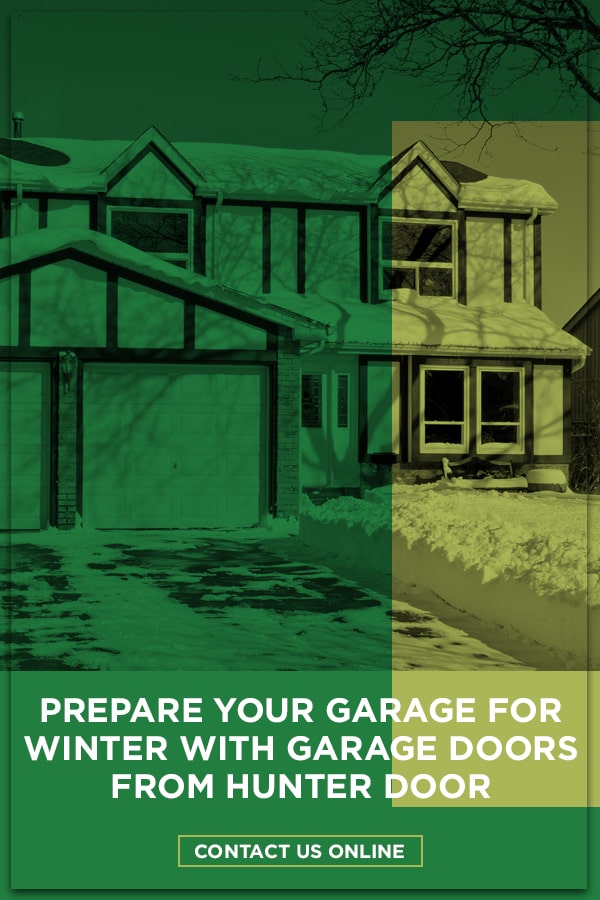Three Ways to Storm-Proof Your Garage Door
The Best Ways to Storm-Proof Your Garage Door
Most people know that high winds from hurricanes and other storms can cause devastating damage. Fewer homeowners know that their garage doors can make an enormous difference in their homes’ safety. Storms and garage doors have a complex relationship that depends on several factors.
Your garage door could fail and become damaged if it is too weak to withstand the wind. Why is this such a problem? If your garage door warps, these high winds will enter your home. Once inside, winds can impact your roof and take it off. Excessive winds can also build pressure in your home, causing your windows to blow out.
Keep reading to learn more about how to secure your garage door during hurricanes and other storms, or contact Hunter Door today to speak to an expert in garage door storm-proofing.
How to Storm-Proof Your Garage Door
How much wind can a garage door withstand? Wind speed design requirements depend on your location as well as on exposure, terrain and direction. Your garage door must be up to code for your safety and that of your home. The wind speed for Risk Category II is between 115 mph and 130 mph. You may need to check your local city codes for the wind speed that your area recommends your overhead door should be able to withstand.
The Hunter Door professionals will help you find the upgrades you may need to follow the code.
1. Install Garage Door Braces
You can strengthen your garage door quickly by installing reinforced garage door braces on the inside of the existing door. Install these temporary braces before a predicted storm to reap the benefits of this inexpensive option.
2. Attach Hurricane Panels
Hurricane panels attach to the exterior of the garage door and offer necessary hurricane protection for garage doors from impact damage. If you have an older garage door, you will need to protect it from high winds to prevent damage to your garage and home.
3. Invest in a Storm-Ready Door
The best and safest option is to invest in a storm-ready door. Installing a storm-proof garage door saves you the time of setting up braces or panels before a storm. After all, some storms can hit unexpectedly. We recommend finding a wind-rated garage door suited for your area, so be sure to check with your jurisdiction or installer.
These storm-proof doors are impact-resistant and can withstand the high winds associated with your region. Upgrading your garage door is one of the most cost-effective home improvements. You receive a high return on your investment because your garage door enhances your home’s safety.
4. Address Any Vulnerabilities in Your Door
Before a storm approaches, meticulously inspect your garage door system. Look for signs of wear, such as rust, loose screws or damaged tracks. You should also test the manual locking mechanisms and ensure they engage securely.
If your door shows any signs of weakness or malfunction, consult a professional for repairs or consider temporary reinforcement measures like braces or panels. Addressing these vulnerabilities is an essential step in storm-proofing your garage door.
Your Garage Door Checklist for Hurricane Season
Follow this checklist when you need to hurricane-proof your garage door:
- Inspect your garage door for any signs of damage, such as rust, loose hardware or frayed cables.
- Test the door’s balance and ensure it operates smoothly.
- If you have a manual override, confirm it’s functioning correctly.
- Install temporary vertical and horizontal reinforced garage door wind braces for quick deployment before a storm.
- If your door is older or not wind-rated, purchase and practice installing hurricane panels.
- Trim any trees or shrubs near the garage that could fall and damage the door.
- Check weather seals around the door’s perimeter and replace any damaged sections to prevent water and wind infiltration.
- Ensure you have the tools and hardware to install braces or panels readily accessible.
- Familiarize yourself with your local evacuation routes and have a plan in case your garage door is compromised.
- See a professional for garage door maintenance to keep it in good shape.
- Store valuable items in higher parts of your garage to protect them from potential water damage.
- Keep the contact information for a trusted garage door repair service handy.
Contact Hunter Door for Garage Door Upgrades and Storm-Proofing Solutions
We’ve staffed our office with trained experts who focus on getting you the information and service you need to storm-proof your garage door. If you’re unsure whether your garage door can resist high winds or if you need help to figure out which option is best for you, please call us at 856-431-3952 or reach out for an estimate.
If a storm damages your garage door, it’s essential that you schedule maintenance to restore its reliable function. Garage doors have many complex parts that can malfunction if damaged. Are you unsure of what to look for? Learn more about spotting when your garage door may need repairs by reading this guide.
Insulating Your Garage Door — When It’s Worth It and When It’s Not
Garage Door Insulation – When It’s Worth It & When It’s Not
Comfort and energy efficiency are factors that may lead you to consider insulating your garage, but are insulated garage doors worth it? The answer may depend on your situation. At Hunter Door, we offer professional, trusted garage door services in South Jersey, including insulated door installation. Keep reading to determine if you should insulate your garage door.
Reasons to Insulate Your Garage Door
Should you insulate your garage door? For some homeowners, insulating a garage door can be a great investment. Consider insulation in some of these circumstances:
- Using the garage year-round: If you need to use your garage in the winter, insulating can help ensure a comfortable temperature. Keeping your garage warm will also help keep your valuable equipment safe and functional.
- Quieter space: Are you doing lots of loud work in your garage? Sounds created by noisy equipment can bounce and reverberate around your garage and into your home, causing quite a disturbance. Insulating your garage will provide a barrier that reduces noise.
- Insulating the attic or bedroom overhead: Without proper insulation, your garage may leak cold air into adjacent rooms. If your bedroom is above your garage, poor insulation can lead to some cold, uncomfortable nights. Cold temperatures can also damage the personal items you store in your attic.
- Blocking fumes and smells: If air and noise can escape your garage and seep into your home, so can unpleasant odors and harmful chemicals. Insulation can seal the cracks that allow air to permeate surfaces, ensuring your family’s safety.
- Protecting plumbing: If plumbing runs through your garage, leaving it unprotected can be very damaging. Cold temperatures can cause a burst pipe that may damage your home and require expensive repairs. If piping goes through your garage, you should insulate it.
Reasons to Opt Out of Garage Door Insulation
Garage door insulation isn’t for everyone. Consider holding out in these situations:
- Absence of heating or cooling: Insulation isn’t an all-in-one fix, but rather a supplement to increase the effects of other temperature-controlling strategies. If you aren’t doing anything to control the temperature, insulation won’t have any effect. Insulation helps retain heat, so if you aren’t actively heating the garage, there won’t be any heat to retain.
- Detached garage: If your garage is detached from your home, it won’t leak cold air, odors and noise into living spaces, making insulation less necessary.
Is Garage Insulation Worth the Investment?
There are some scenarios in which garage insulation is definitely worth the investment, especially for New Jersey homeowners. When the cold hits, garage insulation will help keep your home warm. If you use your garage all year long and pump heat into the space, an insulated garage door can retain that heat and help reduce your energy bill. While garage door insulation isn’t for every home, many New Jersey households can see some real benefits.
Contact Hunter Door to Request an Estimate Today
At Hunter Door, we offer great rates on the best professional garage door services in South Jersey. To learn more about our insulated garage doors or request an estimate, contact Hunter Door today!
How Does Winter Weather Affect Your Garage Door?
How Does Winter Weather Affect Your Garage Door?
Residential garage doors are large moving objects but are also huge conveniences to homeowners — especially in the winter when harsh weather conditions can impact you the most – the cold, ice and snow. What happens when the cold of winter starts to affect your garage door?
Garage door problems can occur in cold weather that all homeowners should know about. While some of these issues are more serious than others, all of them have a fix.
Frozen Ground
When water pools at the foot of your garage door after a heavy rain or snowmelt, it becomes susceptible to freezing. In this case, the frozen water may seal your garage door shut, preventing you from accessing the garage or storing your vehicle. Luckily, this is an easy fix – you can sweep away any puddles or snow to prevent your garage door from sticking in cold weather.
If your garage door is frozen, try some of the following remedies:
- Scraping: Use a scraper to scratch off the ice.
- Release cord: Open the door manually using the emergency release cord – once the door is operating normally it can be reconnected to the garage door opener.
- Heat gun: Melt the ice using a heat gun (or hairdryer).
Ice Between Panels
Most garage doors are sectional or have panels that separate with hinges as the door opens and closes. In cold weather, the openings between these panels can collect moisture and freeze, preventing the door from opening.
Similar to solving a frozen garage door, warm air from a heat gun (or hairdryer) can melt the ice between the panels and allow the door to operate properly. So as to not damage the door, scraping or pouring hot water on the panels is NOT recommended.
Your Garage Door Is Probably Metal
Most residential garage doors are metal – and most likely steel (although some may be aluminum). Steel is affected when it’s cold by contracting. And while this may not affect the garage door panels very much – it can cause issues with the components of the door – hinges, cables and especially springs. The spring or springs (depending upon your setup) handle lifting and lowering the weight of the door. When temperatures drop and the garage door and the components spend the night in sub-freezing temperatures your garage door may not work as planned. Sometimes warming temperatures will solve the problem but if the door is opening slow, not opening at all or really noisy when opening then it’s time to sort out what’s going on. Sometimes, it may just be routine maintenance like lubrication (see below) or it may be time to replace worn or broken parts before the door comes off track or causes damage to the garage door sections.
Routine maintenance is a great project for a homeowner, however other repairs like hinges, cables and springs – may be best if left to a garage door professional for service.
Lubrication Issues
Your door has a lot of moving parts and must be properly lubricated to ensure that it opens smoothly, especially in the winter or it may get stuck or jam shut completely. On the other hand, too much lubrication can lead to a similar problem and cause the same types of issues.
For the best results, use a lubricant specific to garage doors or, if you live in an especially harsh environment, a lubricant suited to your specific environment. A good rule to follow is to lubricate ONLY the moving parts of the door – hinges, pullies, rollers and torsion springs (mounted on a tube above the door – not the springs that stretch out next to the track). Spray lubricant on the part of the hinge where the upper and lower part are joined, for rollers spray where the stem meets the roller (or wheel-looking part that’s in the track) and for torsion springs – give a good spray or two to the full length of the spring. Normally there is NO reason to lubricate the actual door tracks.
Contact Hunter Door for Garage Door Service Today
If you experience a major issue with your garage door in the winter, the experienced technicians at Hunter Door can help. We offer expert garage door repair and installation services performed by highly trained professionals to ensure that your door looks and functions as it should. And even if it’s not a “major” issue don’t hesitate to give us a call – sometimes a quick conversation is all it takes to solve the problem and we are here to help!
Contact us to learn more about our services today!
View More Winter Garage Door Care Resources
How to Keep Your Garage Warm During Winter
Updated Dec. 12, 2023 12:01 PM
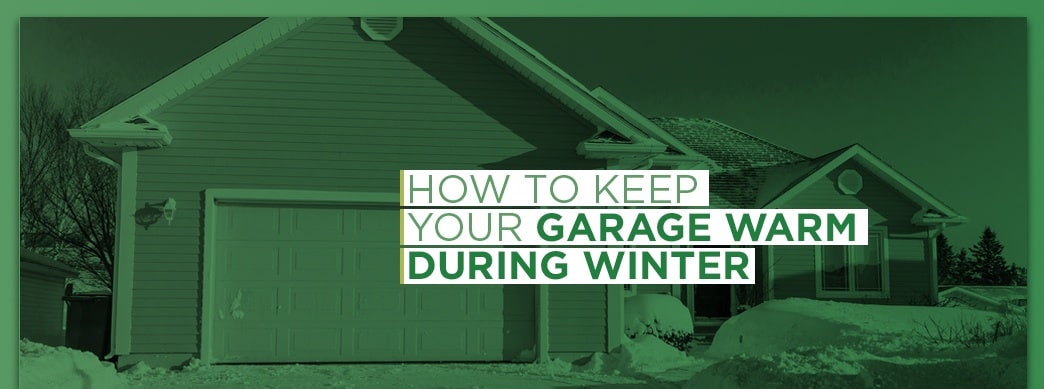
How to Keep Your Garage Warm During Winter
Although mainly designed to store cars and other items, garages can be converted into a variety of other living spaces, including workspaces, TV dens and cozy bedrooms. But there’s one factor that keeps many homeowners from repurposing this space — they’re uninsulated. When winter hits, most garages become cold and uncomfortable. However, insulating your garage is a more straightforward process than you might imagine, and doing so can make your garage warmer, just like any other room in your home.
Table of Contents:
- 3 Ways to Keep Your Garage Warm During Winter
- 7 Steps to Prepare Your Garage for Winter
- How to Insulate a Garage Door for Winter
If you’re interested in taking on this rewarding DIY project, check out our tips on the best ways to keep your garage warm in the winter, or contact our team of professionals today.
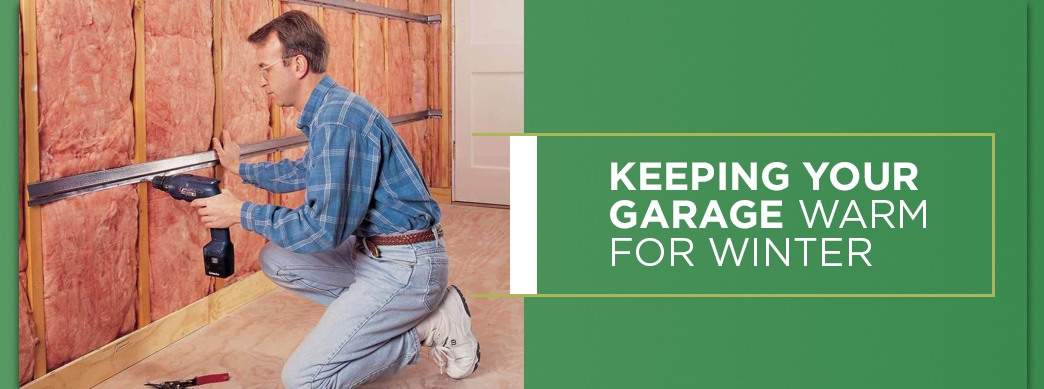
3 Ways to Keep Your Garage Warm During Winter
Turning your garage into a warm and toasty space involves a few steps, all of which should be completed before winter arrives.
- Reduce heat loss by insulating walls
- Insulate garage door and inspect weatherstripping
- Create heat by installing a heater
1. Insulate Your Garage Walls To Limit Heat Loss
Once you’ve sealed all the gaps in your weatherstripping, you can start to insulate your walls. You will want to use fiberglass batt insulation to do this, and it is essential to choose the correct thickness — which will depend on your garage walls. Make sure to read the installation guide carefully before installing the insulation.
2. Insulate Your Garage Door
Even after replacing the weatherstripping on your door, if the garage door itself is not properly insulated, you could still lose a considerable amount of heat.
You can find several specialized kits to help you with this task, which includes fiberglass, foam boards and reflective barriers.
When insulating a garage door, make sure the insulation is carefully cut so that it fits the garage door panels perfectly. Then, use an adhesive to secure it in place. If you’re having trouble with this task or still feel cold after installing the insulation, the best option may be to replace your current garage door with an insulated one.
Some excellent insulated garage doors have been developed and are highly effective at keeping the heat from escaping — which can keep you warm and can save you significantly on heating bills during the winter.
3. Install a Space Heating Unit In Your Garage
Weatherstripping and insulation can keep cold air from coming in, but they may not be enough when it comes to heating your garage in winter. If you want to keep your garage warm, installing a unit heater is a good idea. These appliances do not take up much space and are quite affordable. You can choose an electric or gas heater, and if you want a highly energy-efficient option, you can opt for a mini-split heat pump.
Even with a heater, insulating your garage door and walls is smart. Insulation prevents the heat from escaping and helps your heater be more effective at keeping your garage warm.
7 Steps to Prepare Your Garage for Winter
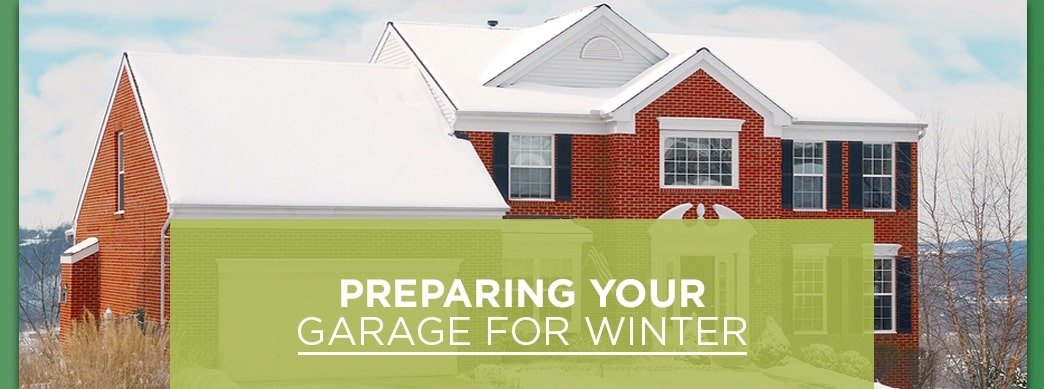
Before winter even arrives, here are a few things you can do to get your garage ready:
1. Clean
Before you can properly winterize the garage, you need to thoroughly clean the space. Take a stiff broom and give the floor a thorough sweeping, removing all dirt, debris, leaves, mulch and insects. Remove all cobwebs, dirt and dust on the walls as well. Once everything is in its proper place, you’ll be able to move around and access the parts of the garage that relate to its warmth, including the garage door, your winter products, pipes, the water heater, the heater and each wall.
2. Inspect the Weatherstripping
Close the garage door, turn the light off and look for any light coming in from the outside. If you find any gaps, this means heat can escape. Inspect your weatherstripping around your door and replace any seals that are damaged or missing. It is normal for it to become cracked or brittle with time.
When removing your existing weatherstripping, make sure to scrape off any remaining sealant, then apply the new weatherstripping with care. Measure and align it properly so that the seal is tight and able to block out cold air and wind. To do this, close the door. Then position the weatherstripping so that the flap is flat against the door.
It’s also recommended that you clean your weatherstripping using a good all-purpose cleaner. When weatherstripping is well-maintained, clean and free of debris, it’s more able to do its job for longer — potentially years to come — without breaking down.
3. Inspect the Garage Door
All garage doors require an annual inspection, and right before winter is a perfect time for this service. Hire a professional to take a look at the door and identify any issues that may lead to a malfunction. If your door needs to be repaired, it’s best to get it fixed before winter arrives — not when it’s 10 degrees outside, and your garage door won’t close.
Request Your Garage Door Service
4. Lubricate Moving Parts
Ensuring all moving parts of your door are lubricated can help your door function properly and may prolong its lifespan. Cold weather can cause moving parts of your garage door to freeze up. Fortunately, lubricating these parts can help keep the door in good working condition all winter long.
5. Make Sure You Can Access Your Winter Products
Place any equipment you will need to access during the winter, such as shovels, snow blowers and rock salt, where they are easy to access. If they’re buried somewhere in the back of the garage, now is an excellent time to bring these items out. This way, you’ll be able to access them quickly if necessary — including those times when your garage is snowed in, and you need something to clear away the snow.
6. Insulate Your Water Heater
If your water heater happens to be in your garage, insulating it may be a good idea. If you own a newer one, chances are it already comes with insulation. If you have an older model, find out its R-value, which measures thermal resistance. Its R-value should be at least 24. If the value is any lower, consider adding insulation.
7. Protect Exposed Pipes
If you have pipes that carry water from the garage into your home, winterize them by shutting them off and purging the water from them. Then use foam or plastic pipe insulation to cover up exposed water lines. A more economical way to do this is with old towels and duct tape.
How to Insulate Your Garage Door for Winter
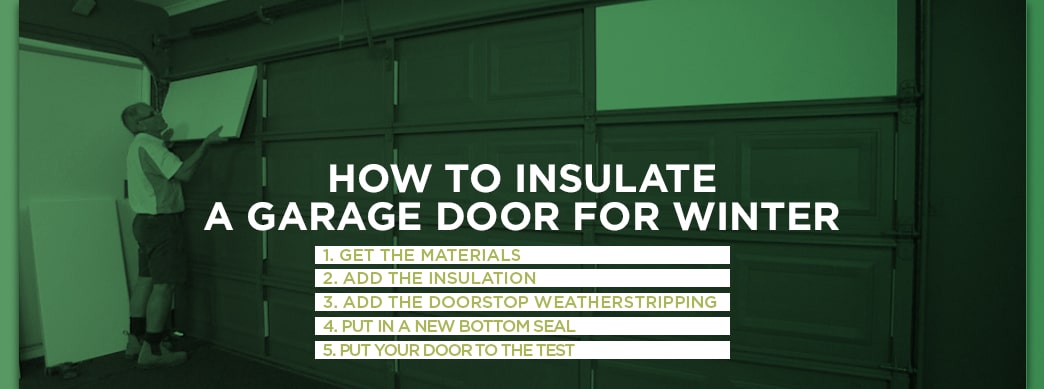
As you learned above, insulating your garage door for winter is an important part of making your garage comfortable in cold weather. Below, we’ll go over the steps involved in insulating your garage door and the materials you’ll need to to do so.
Insulated garage doors with an R-18 energy efficiency can warm garages by 12 degrees in the winter and cool them by 25 degrees during the summer, which leads to energy savings. With the cost of the garage door itself, however, it may not make sense to replace the one you have just for the energy savings. You can insulate your existing door, though, and add doorstop weatherstripping and a new bottom seal to increase your comfort and energy cost savings.
This entire job can typically be finished in about an afternoon. The steps are as follows:
1. Get the Materials
First of all, you’ll need to make sure you have the following tools:
- A utility knife
- A saw
- A tape measure
- A straightedge
- A dust mask
- A hammer
- Nails
In addition to the insulation, you’ll also want to purchase some vinyl weatherstripping for your garage door. Make sure to get enough to seal both the sides and the top. You will want to get a bottom seal as well, also made of vinyl, to go on your track. If you notice your track has any damage, it should be replaced.
2. Add the Insulation
To insulate your door, you’ll first want to ensure you have the right type of insulation — which depends on the R-value you’re looking for and what kind of door you have. The most common types of insulation are:
- Foam board panels: These are rigid panels that are typically crafted from polystyrene. They are usually between 1/2 inch and 1 inch thick and are effective without adding much bulk. R-values for this option range between R-3.3 and R-6.5.
- Reflective insulation: Reflective insulation comes in rigid boards or in rolls, and it has a reflective aluminum covering that is applied to one or both sides. Since it reflects radiant heat, this option is ideal if your garage gets very warm during the summer time or if you live in a warm climate. The typical R-value for reflective insulation ranges between R-3.5 and R-6.
- Batt insulation: Batt insulation is flexible, and it’s also often used as insulation for exterior walls. It’s constructed from fiberglass with a backing of foil or paper to act as a barrier for moisture and air. The typical R-value range for this insulation type per inch of thickness is R-3 to R-4. One note, however, is that this may not be the best option for garage door insulation if you’re not using a kit.
For most doors, rigid insulation options are the easiest to use. With steel doors, though, flexible insulation, such as batting, can also work because it can be stuffed in the frames that surround the panels.
Once you have determined the insulation you need, you can either go with an insulation kit or just gather all of the supplies yourself. The advantage of a kit is that it includes a more complete set of materials — such as gloves and a utility knife — as well as pre-cut panels you’ll just have to trim down to fit your door.
As far as the installation process with a kit, if you’re using the R-8 fiberglass vinyl-faced insulation kit, for example, you’ll follow these steps:
- Clean the Product. Wash each panel using a rag and a cleaning spray. Then, rinse them using clean water and let them dry out.
- Install the Retainer Pins. Locate the point that is exactly one foot from each of the panel’s edges and exactly halfway between the two horizontal rails. Mark this point, then take off the sticky backing paper and stick the base of the retainer pin on the panel. Two retainer pins should be placed on every panel.
- Cut up the Batting. Roll the batting out on plywood with the vinyl facing down. Then, measure the dimensions of each panel and mark these measurements on the batting. However, add one inch to both the height and the width to ensure a tight fit. As the size of each panel might be different along the door, measure them as you go along instead of pre-cutting all of them using a single measurement. Use a utility knife to cut the panels while compressing the insulation with a straightedge.
- Insert the Batting. Take the insulation you cut, center it in the panel and push it into the retainer pin until it pops through the vinyl side. Then, put the retainer cap on the end of the pin, and it should snap into place.
- Repeat. Continue this process until you have covered all the panels with the insulation.
If you decide against a kit, the installation process will be very similar. You’ll likely just have more to cut, and you’ll need to make sure you have all the necessary tools and other materials — such as a way to attach your insulation to the door. Most people go with rigid panels and cut them to the correct size with a table saw or a sharp utility knife.
3. Add the Doorstop Weatherstripping
Now it’s time to seal around the door:
- Beginning at the top of your garage door, fasten the weatherstripping to the top jamb. Temporarily secure the stripping by pounding in the nails only halfway.
- Attach the side doorstops in the same fashion. The top and side stripping should meet at a 45-degree angle.
- Put pressure against the door to see how it might deal with strong winds. Then, adjust the doorstops inward so that it will seal against the door even in high winds.
- Hammer in the nails in completely. If you can’t properly adjust the doorstop because your door has too much play — or light is coming through the weatherstripping — take out the hinges and replace them with spring-loaded ones that press the garage door against weatherstripping.
4. Put in a New Bottom Seal
Most garage doors feature a track at the bottom that holds a vinyl seal. The sun can cause this vinyl seal to harden, crack or break off, allowing cold air to enter. To retain this seal, the slots found at each end are often crimped. Open these crimps and take out the old seal, and then put in your new one.
5. Put Your Door to the Test
If your door is correctly balanced, it should stay in place if it is lifted partway and then released. However, because insulation makes the door heavier, the balance may be thrown off. If your door falls down when you release it, call a professional to readjust the tension of the springs. Ignoring this problem may cause damage to your garage door opener.
Benefits of an Insulated Garage Door
Besides keeping you more comfortable, winterizing your garage door provides many other advantages:
- It can help keep the rest of your home warm. Cold air won’t be seeping into the rest of your living space from the garage.
- It can lead to energy cost savings. If heat isn’t constantly leaking through your garage door, you’ll spend less on heating.
- It reduces rusting. A well-insulated and well-heated garage keeps out humidity, which can help prevent rusting.
- It reduces noise transmission. If you live near a busy highway or noisy neighbors, you won’t be disturbed by all the noise while in your garage. Likewise, your activities, such as playing a musical instrument or using power tools, are less likely to disturb the neighbors and those inside your house.
- It can make starting your car easier. An insulated garage may help your car start on unusually cold days, and you’re also less likely to have battery issues.
- It can help protect your equipment. If a garage’s temperature gets too cold, the equipment you store there can also get damaged. If you have a power washer with some water remaining in the lines or pump, for instance, freezing and cracking can occur.
- It can make the summers more comfortable, too. If you live in a climate with hot summers, your insulated garage door can keep your garage a few degrees cooler during the hottest months. This could make a huge difference if you spend significant time working in your garage in the summer.
Prepare Your Garage for Winter With Garage Doors From Hunter Door
If you don’t want to go through the trouble of installing insulation for your existing door, there’s an easier option: replacing your door with an already insulated model.
At Hunter Door, we offer an extensive collection of insulated garage doors. Our doors come in a wide variety of colors, styles and degrees of insulation — so we’re confident you’ll be able to find a model that suits your personal tastes and insulation needs. We are a certified Clopay® dealer and also sell industry-leading brands such as ProVia, LiftMaster® and Genie®.
If you live in or around South Jersey, come to Hunter Door for all your garage door needs. In addition to selling high-quality garage doors, we also perform installations, repairs and even custom painting services to ensure your new door perfectly matches the look of your home.
If you have any questions regarding our products, contact us online or call us at 856-482-2325, and our knowledgeable representatives will be glad to assist you. You can also visit our showroom in person, and we’ll help you pick a door that best fits your budget and preferences.
View More Resources for Winter Garage Door Care
Areas We Serve
How Does Summer Weather Affect Your Garage Door?
How Does Summer Weather Affect Your Garage Door?
Summer weather is often marked with high temperatures, direct sunlight and fierce thunder and lightning storms that can affect the appearance and functionality of your home’s garage door and garage door opener. To keep your door in top-notch condition and ensure reliable operation during the summer, it’s best to understand what types of summer weather can affect your door and learn some simple tips to keep your garage door system in good shape.
How the Sun Can Affect Garage Door Sensors
Garage door opener photo safety sensors are a safety feature of your system designed to stop the door from closing on an object in the garage door’s path. While this feature is great for ensuring safe daily garage door operations, direct sunlight can actually confuse the sensors into thinking there’s something blocking the door. During the summer, if your garage door opener closes intermittently, sunlight may be interfering with the photo eye sensors.
To prevent this malfunction, some manufacturers produce shades for the sensors or the other solution is to “flip” the sensors – one is a sender and one is a receiver – swapping the sender sensor and receiver sensor from side to side will also help to eliminate interference from the sun. As always, the trusted professionals at Hunter Door are available to provide advice or can help with inspecting the problem and finding a dependable and affordable solution.
High Humidity Levels Create Sticky Operations
Summer temperatures are often accompanied by uncomfortable and sticky humidity levels. High humidity can make your garage door stick to its perimeter seal especially if the door is painted and even more so if the door has been recently painted. The best solution to a sticking door is to make sure there is no paint on the back side of the perimeter seal – if you find there is paint on the back of the perimeter seal – take careful efforts to remove the excess paint without damaging the soft, pliable flap of the perimeter seal. In certain cases, the perimeter seal may need to be replaced – if you think that is the case, call Hunter Door for some friendly advice on replacing the perimeter seal – available in a variety of colors and sizes. And if it’s not a project you are willing to tackle – we can quickly schedule a service call and have your garage door back to working normally.
Thunderstorms and Unexpected Power Outages
During the summer months, you can often expect surprise thunderstorms that are often marked with power outages. While the materials of the door should protect against the excess moisture and heavy winds, homeowners should know how to safely open their garage door when the power goes out.
If power outages are frequent in your area, then you may consider purchasing a battery backup system for your garage door opener so the door can still safely operate during power outages. Without battery backup, homeowners should know how to manually open and close the garage door by removing the door from the automatic opener using the red emergency cord.
Ask About Our Garage Door Services
Keep Your Garage Door Operating Properly With Hunter Door
When you want to maintain the quality and functionality of your garage door, trust the professionals at Hunter Door with performing regular garage door maintenance — or let us help you select and install a new beautiful and durable Clopay garage door crafted to withstand extreme climates for many years. The experts at Hunter Door have over 40 years of garage door and garage opener installation, repair and maintenance experience, and we pride ourselves on offering the highest-quality products and services with a superior customer experience.
Learn more about our garage door services today by calling us at 856-431-3952 or complete our online form to request services. We also offer free project quotes for all of our customers — just fill out our online estimate form!

